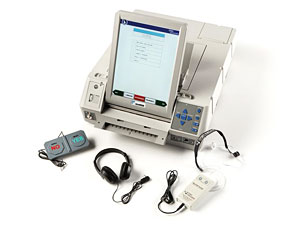The AutoMARK Voter Assist Terminal (VAT) makes voting with privacy and independence an option for all voters, and particularly those with disabilities. The AutoMARK is an optical scan ballot marker primarily designed for use by people who are unable to personally mark an optical scan ballot due to physical impairments or language barriers.
As a result of the Help America Vote Act (HAVA) passed in 2002, North Dakota responded to the requirement for accessible voting systems and entered into an agreement with ES&S to provide the AutoMARK in all precincts of the state. Since 2005 all state voting sites are to have the AutoMARK available and also are to have personnel on hand during elections to assist voters in its use.
The AutoMARK functions as a combination of several devices: a scanner, printer, touch screen display, and input device. The data for any specific election is stored on a compact flash card. Using proprietary software, an election official is able to convert election data from the regular ballot for use in the AutoMARK. When a voter inserts their ballot into the AutoMARK , it searches for a match to the precinct identification code found on each ballot and when found allows the video and audio display of its contents. The voter is then able to carry out their voting by using the touch screen, a puff-sip device or their own switch access device, or by following audio prompts through a headset along with using the Braille-coded keypad. Additionally, there is a screen privacy option so that voters with visual impairments can be assured that their voting remains private.
Navigating through the election ballot is made simple with text and audio prompts, as well as reminder screens that alert you to having over or under-voted for any particular contest. An additional plus is the verification page that summarizes your selections and allows you to return to any particular spot on the ballot. Once satisfied with your choices, selecting the final “Mark Ballot” will trigger the AutoMARK to mark your ballot and eject it from the front tray. If the returned ballot is not to your approval, you may request another ballot from the election officials and try the process again. If acceptable to you, you’re on to depositing it in the collection bin(s) with everyone else’s ballots.
Beginning this Spring, IPAT has been involved in an accessible voting technology grant project (RAAV) that has resulted in dozens of personal demonstrations to voters with vision impairments or motor challenges all across the state. Your own demonstration can be scheduled through contacting us at either our Fargo or Bismarck centers.
See the recent video clip of Peggy Shireley from our Bismarck center showcasing the AutoMARK for KX News. On the video she shares stories about 2 voters with vision challenges and how the AutoMARK has helped them feel re-connected to their communities!


Hi Chris. I’m a speech pslohtogiat, and I’ve worked quite a bit with the proloquo2go app with a couple of students with severe speech disorders. It is wonderful for them, though it should be stressed that it isn’t a magic bullet that enables instant, fluent communication. It is akin to learning a new language, with a lot of time and practice required before it comes quickly and naturally. I can tell you that proloquo2go runs on the ipod touch, the iphone, and the ipad. It is easiest on the ipad because there is plenty of room on the screen to see more word choices (you touch images and it speaks the word). However, some students prefer the ipod touch or iphone because they are easier to carry around. I wish it would run on the android platform so that something like the new kindle fire from amazon (much cheaper!) might be able to run it.As for your situation, I would consider asking his speech therapist (if he has one, probably through his IEP at school) which app they would recommend, and which device you should get to run that app. Proloquo2go costs nearly $200 just for the app. For the person who is unable to express themselves through speech, it can be worth every penny and then some, unlocking so many doors and allowing them to communicate. I recommend it. For someone with more mild speech problems, it may be overkill and not helpful. There are many many other communication apps, but I haven’t tried them. I’ve heard good things specifically about tap to talk. I hope you come up with a good fit for your grandson!